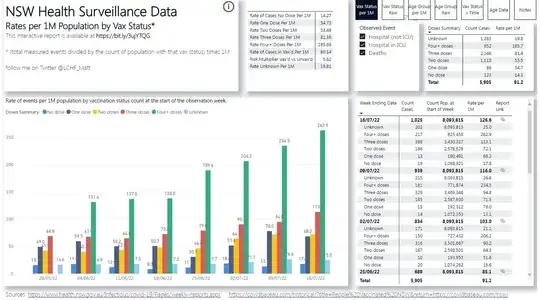Twitter user @LCHF_Matt has created a NSW Surveillance Report which is a dashboard that compare the rate of "events" (which can be configured to include COVID-19 deaths, COVID-19 ICU admissions, COVID-19 non-ICU hospital admissions or reported COVID-19 infections) per capita from New South Wales, Australia, against their vaccination status. He says it is based on data published by NSW Health.
The graph below (which includes hospital admissions + deaths) appears to show that people with four or more doses are at most risk, and unvaccinated people at the least risk.
The Notes tab includes this summary:
It is well known that younger people are less likely to need hospitalisation as a result of Covid-19 than older people and that vaccination rates are lower in the very young. The hospitalisation and death observations in the unvaccinated cohort is no doubt skewed by this fact. These data still however indicate that the cohort of people currently unvaccinated are, collectively at least, not being as adversely affected by Covid-19 resulting in the need for hospitalisation as are the vaccinated cohorts. This could be the result of lower infection rates, lower hospitalisation rates when infected, both, and/or other mechanisms unknown […]
Note that apparently NSW Health doesn't publish the data needed to normalize for age. The author acknowledges that for this reason, the chart cannot demonstrate causation.
The graph has been referenced by Joel Smalley's blog, on Del Bigtree's show The Highwire, and endorsed by the Director General of the Israel Institute for Biological Research (IIBR) Shmuel Shapira.
Is this chart accurate? Does it misinterpret the NSW Health data? Is there a correlation between COVID-19 vaccine doses and hospitalizations in NSW?
